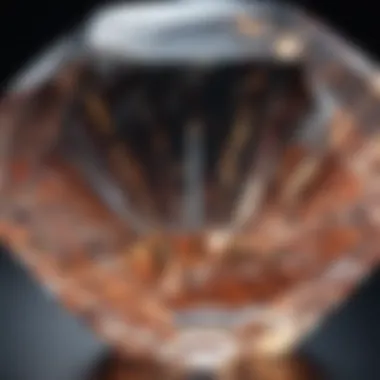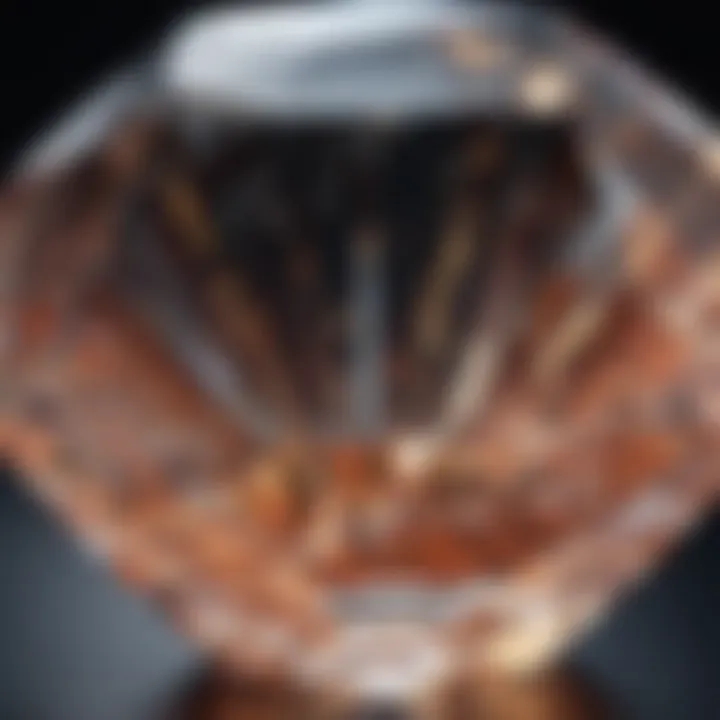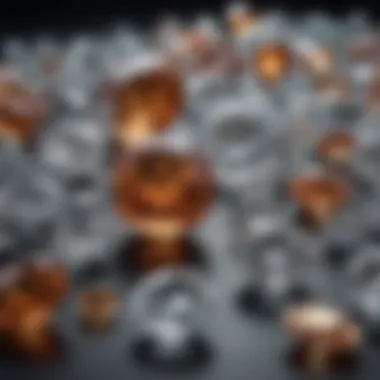Understanding Diamond Stone Value: A Comprehensive Exploration


Intro
Understanding the value of diamond stones is crucial for various stakeholders, including collectors, jewelers, and enthusiasts. This domain encompasses more than just numbers or prices; it involves an intricate interplay of multiple factors that shape how diamonds are perceived in the market. As we delve into this comprehensive exploration, we shall touch upon aspects such as diamond grading, cultural significance, economic conditions, and the subjective elements influencing value.
Gemstone Overview
Definition and Origins
Diamonds are crystallized forms of carbon created under intense pressure deep within the Earth's mantle. They emerge over millions of years. Their clarity, brilliance, and longevity make them coveted in both industrial applications and jewelry. The first diamonds were sourced in India, believed to have been used for adornment as early as the 4th century BC. Over time, major sources shifted to Brazil, then to Africa, significantly affecting supply and demand.
Historical Significance
Historically, diamonds have been imbued with meanings surpassing mere aesthetics. In many cultures, diamonds symbolize power and invincibility. Their rarity significantly bolstered their prices, influenced by conquests and trade routes. The famous Koh-i-Noor diamond, for example, was linked with the British monarchy and has cultural stories spanning centuries. Such historical narratives impact modern valuations considerably, as provenance often plays a role in pricing.
Gemstone Properties
Hardness and Durability
Diamonds are esteemed for their unparalleled hardness, rated a 10 on the Mohs scale. This property makes them resilient, ideal for everyday wear in jewelry. Their ability to resist scratches impacts their desirability and subsequently their value. However, it's essential to note that while diamonds are tough, they are not indestructible; they can chip or break under direct force.
Color and Clarity
The color and clarity of a diamond also heavily influence its value. The Gemological Institute of America (GIA) defines a D to Z scale for color grading, with D being completely colorless and Z showcasing noticeable color. Diamonds with lower color grades may retain beauty but are often valued less. Clarity, measured by the presence of inclusions or blemishes, also plays a vital role. Higher clarity grades yield higher prices due to their appearance and rarity.
"The beauty of a diamond lies not solely in its brilliance but in its unique qualities that define its value."
The Intricate Nature of Diamond Value
Understanding the intricate nature of diamond value is essential for anyone engaged in the world of gemstones. Diamonds are not merely beautiful objects; their value is shaped by a variety of factors, both objective and subjective. This complexity adds an enriching layer to the study of gemstones, making it a vital subject of exploration.
When we consider the concept of value in relation to diamonds, we must look beyond mere pricing. The significance of diamonds spans cultural, social, and economic realms. Their worth can fluctuate based on market dynamics, personal significance, and even historical context. This nuanced framework influences how buyers perceive diamonds and, subsequently, how they invest in them.
In this article, we will explore specific elements that contribute to diamond value. A deeper understanding can lead to better decisions for collectors, enthusiasts, and appraisers alike.
Defining Value in the Context of Gemstones
Value in the context of gemstones, particularly diamonds, is multifaceted. It does not only derive from inherent qualities such as size or clarity but also from emotional and historical significance. When individuals refer to the value of a diamond, they often mean its monetary worth; however, this is merely one dimension.
To define diamond value accurately, we must consider several dimensions:
- Intrinsic attributes: These include the well-known Four Cs—cut, color, clarity, and carat weight. Each factor has a direct correlation with value.
- Provenance: The origin of the diamond can enhance or diminish its perceived worth. For instance, diamonds from conflict zones may be viewed less favorably.
- Cultural relevance: Various cultures attribute different meanings and significance to diamonds. Some see them as symbols of love, while others may view them as status symbols.
In summation, defining value in the context of gemstones involves a balance of measurable characteristics and intangible factors.
The Economic Framework for Diamonds
The economic framework for diamonds is complex and influenced by many variables. Market demand, supply chain logistics, and geopolitical factors all come into play. Understanding these dynamics is crucial for anyone interested in the economics of the diamond industry.
Several considerations impact the economic framework, including:


- Market Demand: The popularity of diamonds dictates pricing. Events like anniversaries or engagements spur demand significantly.
- Supply Chain: The journey from mine to market involves multiple stakeholders. Each link can add costs that ultimately shape consumer prices.
- Global Economic Conditions: Economic stability or instability can heavily affect consumers’ purchasing power, thereby influencing diamond sales.
"Diamonds are not just a product, they are a commercial symbol that fluctuates in value in response to consumer perceptions and market conditions."
The Four Cs of Diamonds
The value of diamonds is largely determined by a combination of four critical factors known as the Four Cs: Cut, Carat Weight, Color, and Clarity. Understanding these parameters is essential for any potential buyer or enthusiast, as they collectively inform the assessing and pricing of diamonds in the market. Each aspect influences not only the appearance of the stone but also its overall desirability and marketability. Knowledge of the Four Cs can help individuals make more informed choices and recognize the quality of the diamonds they are considering for purchase or investment.
Cut: The Craftsmanship Behind Brilliance
Cut refers to how well a diamond has been shaped and faceted. This factor directly impacts the stone's brilliance and sparkle. A well-cut diamond reflects light beautifully, whereas a poorly cut stone may appear dull or lifeless, regardless of its other qualities. The proportions and angles of the facets influence how light enters and exits the diamond. Different cutting styles, such as round, princess, and emerald, can yield varying opulence and light performance.
Good craftsmanship enhances a diamond's appeal. However, it is noteworthy that cut quality can be somewhat subjective. Personal preferences may vary, leading some buyers to favor certain shapes over others. Understanding these subtleties in cut can help buyers find a diamond that fits their aesthetic taste.
Carat Weight: Impact on Perceived Value
Carat weight is a key metric in assessing the value of a diamond. One carat is equivalent to 200 milligrams. As carat weight increases, so does the rarity and, typically, the price. However, it's essential to recognize that carat weight alone does not define a diamond's value. Larger diamonds are rarer and thus command higher prices per carat.
In practical terms, small increases in carat weight can result in significant jumps in price. For example, a diamond weighing 1.00 carat might be substantially cheaper than one weighing 1.10 carats, even if their qualities in terms of cut, color, and clarity are otherwise the same. This trend often means that buying just under common weights—like 0.90 or 1.90 carats—can be a strategic approach for budget-conscious buyers.
Color: Spectrum of Perception
Color in diamonds ranges from colorless to shades of yellow or brown. The most sought-after diamonds are near colorless, with grades from D (colorless) to Z (light yellowish). The reason color is so critical lies in light interaction. Colorless diamonds reflect more light in a more vibrant way, leading to higher perceived value.
However, fancy colored diamonds are an exception to this norm. These stones possess a rich saturation of hue and can command higher values than colorless diamonds based on their rarity and beauty. Buyers need to consider personal preference and the existing market when evaluating a diamond's color quality.
Clarity: The Role of Imperfections
Clarity refers to the presence of internal flaws, or inclusions, and external blemishes. Clarity grading ranges from Flawless (no inclusions visible under 10x magnification) to Included (inclusions visible to the naked eye). Generally, the higher the clarity, the more valuable the diamond. A stone with fewer inclusions appears more radiant and clear, contributing to its overall desirability.
However, it’s important to note that some inclusions may not significantly impact a diamond's appearance. Some buyers appreciate stones with minor inclusions, as they can provide unique characteristics that differentiate one diamond from another. The value attributed to clarity will depend on the market and personal perception, emphasizing the subjective nature of diamond valuation.
Understanding the Four Cs is fundamental for making informed decisions about diamond purchases. They influence a diamond's appearance and market value, tailoring the buyer's experience to their preferences and budget.
Market Dynamics Influencing Value
Market dynamics significantly shape the valuation of diamonds. Understanding these forces is key for all stakeholders—whether buyers, sellers, or investors. Various elements, including supply chain considerations, emerging market trends, and resale values, converge to dictate the price and desirability of diamonds in today's economy.
Supply Chain Considerations
Supply chain aspects heavily influence diamond pricing. The journey of a diamond from mine to market involves numerous steps, each incurring costs that contribute to the final selling price. Key players in the supply chain include mining companies, wholesalers, retailers, and evaluators. Each step adds a layer of value but also affects transparency. Factors such as production output, geographic location of mines, and geopolitical stability can all impact supply levels. The discovery of new diamond mines can potentially lower prices by increasing availability, while political unrest in key mining regions may constrain supply, driving up prices.
The complexity of the diamond supply chain requires potential buyers to consider both sourcing details and ethical implications during their purchasing process.
Furthermore, mining practices come under scrutiny today, as consumers are increasingly engaged in ethical sourcing. Fair trade practices, environmental sustainability, and the social implications of mining communities are more relevant than ever. Awareness of these issues impacts consumer decisions and can affect market dynamics.
Emerging Market Trends
The diamond market is also sensitive to shifts in consumer preferences and economic conditions. Emerging markets, particularly in Asia and Africa, are becoming significant players in diamond demand. Countries like India and China are witnessing a rise in the middle class, leading to increased consumption of luxury goods, including diamonds.


These trends highlight the importance of regional economic stability and disposable income levels. As more consumers in these regions enter the market, the overall demand for diamonds is likely to increase, which may elevate prices.
Additionally, millennials and Gen Z consumers exhibit distinct preferences that differ from previous generations. They often favor environmentally-conscious products and are influenced by trends in social media. This generational shift may lead to increased demand for lab-grown diamonds and ethically-sourced natural stones, potentially affecting traditional diamond values.
Resale Value and Its Implications
The resale market for diamonds is another critical aspect of valuation. Different factors, such as market demand, the diamond's characteristics, and trends in luxury goods, dictate resale value. Unlike some other investments, diamonds do not always appreciate in value over time.
Many buyers assume diamonds will retain their value; however, historical trends show that resale values can fluctuate. Factors impacting resale value include:
- Market demand at the time of sale
- The diamond's original purchase price
- Its grading report and certification
- The condition and setting of the piece
Sellers must also consider that resale typically occurs through established jewelers or online platforms, and each channel may offer different pricing structures and fees. Understanding these nuances can help buyers make more informed decisions about their investments.
In summary, market dynamics surrounding diamond valuation extend beyond mere individual characteristics of the stones themselves. Supply chain considerations, evolving market patterns, and the complexities of resale all interact together, forming an essential backdrop for comprehending diamond values in today’s market.
Cultural and Historical Influences
Cultural and historical influences play a crucial role in shaping the perception and value of diamonds. Throughout history, diamonds have been imbued with meaning, representing not just wealth but also deep-rooted traditions and emotions. Their significance varies across different cultures, often elevating them to the status of mythic objects. This subsection explores the dimensions of symbolism and status tied to diamonds, as well as the ways diamonds are represented in art and literature.
Symbolism and Status
Diamonds have a profound status in many societies. They are often viewed as symbols of eternal love and commitment. This perception was notably popularized in the 20th century through strategic marketing campaigns, such as the famous slogan, "A diamond is forever." More than luxury, diamonds communicate messages of prestige and success to the wider community.
In various cultures, diamonds also hold symbolic meanings. For example, in India, they have long been associated with power and durability, having been used in royal jewelry for centuries. Moreover, the ancient Greeks believed that diamonds were tears from the gods, augmenting their mystical significance in many circles.
"Diamonds are not merely stones; they are symbols of emotions and aspirations."
Diamonds can reflect the social status of their owners. Ownership denotes exclusivity and affluence, making them a statement piece in one’s personal collection. Their rarity and value often create a desire for ownership not simply for aesthetic enjoyment, but as a measure of one's success in the eyes of others.
Diamonds in Art and Literature
Diamonds have been a recurring theme in art and literature, representing various concepts throughout time. In literature, they are frequently associated with themes of love, betrayal, and human ambition. For example, in Shakespeare's Taming of the Shrew, the titular character references a diamond to convey value and worth. This speaks to diamonds’ deep-rooted place in human culture as objects that encapsulate complex human emotions.
In visual arts, diamonds have been depicted to symbolize wealth, aspiration, and beauty. Iconic paintings and sculptures often feature diamonds either as subjects or as accessories for noble figures, offering a glimpse into their societal importance. This visual representation adds to the allure and mystique surrounding diamonds, further inflating their value.
Ethical Considerations in Diamond Value
The ethical dimensions of diamond value are gaining prominence in modern discussions surrounding gemstones. As buyers become more discriminating about their purchasing habits, understanding the ethical implications has become essential. The popularity of diamonds often brings to light issues such as conflict diamonds and their impact on communities, as well as the practices behind sourcing these stones. Addressing these matters is not only relevant for consumer awareness but also for shaping a responsible market.
Conflict Diamonds and Consumer Awareness
Conflict diamonds, often referred to as "blood diamonds," are stones that are mined in war zones and sold to finance armed conflict against governments. This dark history has led to significant consumer wariness. It is crucial for diamond purchasers to recognize the potential socio-economic implications of their buying decisions.
The Kimberly Process was established to create a system of certification that prevents conflict diamonds from entering the market. However, flaws in this process still exist. Awareness of these flaws is necessary for consumers to ensure they are not inadvertently supporting violence or exploitation.
It is advisable for buyers to inquire about the sourcing of the diamonds they are interested in. Questions may include:
- Where was the diamond mined?
- What certifications does the diamond come with?
- Can the retailer provide information on the supply chain?


Such inquiries help consumers make informed decisions, ultimately fostering a market that values ethical practices.
Sustainable Sourcing Practices
Sustainable sourcing practices refer to the methods used to extract and bring diamonds to market in a manner that minimizes environmental impact and promotes social responsibility. This approach not only protects ecosystems but also enhances the legitimacy of the entire diamond industry.
Many companies are now adopting practices that prioritize environmental stewardship. This includes supporting communities where the diamonds are mined, focusing on fair labor practices, and using methods that reduce ecological damage.
Some of the benefits of sustainable practices include:
- Reduced environmental impact: Sustainable mining techniques help conserve biodiversity and reduce pollution.
- Empowerment of local communities: Fair share of profits allows local workers to gain economically and socially.
- Enhanced consumer trust: As consumers increasingly seek ethically sourced products, companies embracing sustainable practices can attract a more loyal customer base.
Adopting such principles is not merely a trend but a necessary evolution in the industry. By promoting ethically sourced diamonds, the market can shift towards a future where the value of gems is not just measured in carats but also in the stories behind them.
"The value of a diamond goes beyond its physical attributes; it encompasses the ethics and stories tied to its journey from mine to market."
Evaluating a Diamond's Worth
Evaluating a diamond’s worth is a critical component in understanding its overall value in the market. Many factors contribute to how a diamond is appraised and what it can fetch on the resale market.
This evaluation encompasses both aesthetic qualities and relevant market considerations. Buyers should realize that a precise assessment can make a significant difference when purchasing or selling diamonds.
The Role of Appraisals
Appraisals serve as an objective measure of value for diamonds. When an expert evaluates a diamond, they consider the Four Cs: Cut, Carat, Color, and Clarity. These elements each weigh heavily on the final valuation. A trained appraiser will also assess the diamond's proportions, symmetry, and overall craftsmanship. This thorough approach ensures that buyers receive a realistic understanding of what they possess.
Furthermore, appraisals are essential when determining insurance coverage for high-value jewelry. Insurers often require a written appraisal to establish the market value of a diamond, ensuring proper coverage in the event of loss or theft.
Certifications and Their Importance
Certifications play a vital role in the diamond market. Certifying bodies, such as the Gemological Institute of America (GIA) and the International Gemological Institute (IGI), provide independent verification of a diamond's characteristics. This impartiality helps reassure buyers about the quality of their purchase.
A well-recognized certification can also have an impact on the resale value. Buyers often prioritize diamonds with certificates from reputable organizations. Consequently, the presence of certification can enhance a diamond’s appeal in the marketplace.
The Future of Diamond Valuation
The topic of diamond valuation has evolved significantly in recent years. Understanding its future is essential for a variety of stakeholders. This includes miners, jewelers, investors, and consumers. As we move forward, new technologies and shifting consumer attitudes play a pivotal role in how diamonds are perceived and valued.
Technological innovations are transforming how diamonds are graded and valued. Advancements in gemology could lead to more precise and reliable grading systems. These improvements could help in reducing the subjective nature of diamond evaluations. It makes it easier for consumers to trust the worth of their purchases. Additionally, the impact of ethical sourcing and transparency will become increasingly relevant. Buyers are now more concerned about where their diamonds come from and the methods used in extracting them. This article section will explore these evolving dynamics further.
Technological Advancements in Gemology
Recent technological advancements in gemology are notably enhancing diamond valuation. Artificial intelligence tools are being integrated into grading systems. AI can analyze specific gemstone characteristics with remarkable accuracy and speed. These technologies can help minimize human error in evaluations, producing consistent results. Reports generated by AI systems are seen as increasingly reliable by consumers. This includes methods such as machine learning to predict price points based on various criteria.
Moreover, spectroscopy and other analytical techniques are improving the identification of synthetics and treatments. These advancements aid in creating a clearer marketplace. They allow buyers and sellers to understand the true nature of the diamond’s characteristics. Furthermore, modern databases are becoming more robust. They provide detailed logging and tracking of diamonds through their lifecycle, resulting in comprehensive historical records. This can significantly impact valuation, as transparent provenance adds to a diamond’s desirability.
Shifts in Consumer Preferences
Consumer preferences are undergoing substantial shifts, influencing diamond value significantly. Younger generations often prioritize ethical considerations alongside traditional metrics like quality and carat weight. They are inclined toward lab-grown diamonds due to their lower costs and the perception of being environmentally friendly. This trend may reshape market dynamics and the valuation frameworks currently in place.
Market data shows an increasing number of buyers choosing lab-grown diamonds over natural ones. Additionally, the emotional value of diamonds is shifting. Consumers now focus more on personal significance than on status symbols. Pieces that reflect individuality and creativity are appreciated more than just the traditional definitions of luxury.
- Increased demand for ethical sourcing
- Preferences for unique, custom designs
- Willingness to pay for sustainability
These shifts mean diamond valuations may need to adapt to reflect changing consumer values. As a result, traditional value metrics may become less relevant.
"Understanding future trends in diamond valuation is key to navigating the market effectively."



